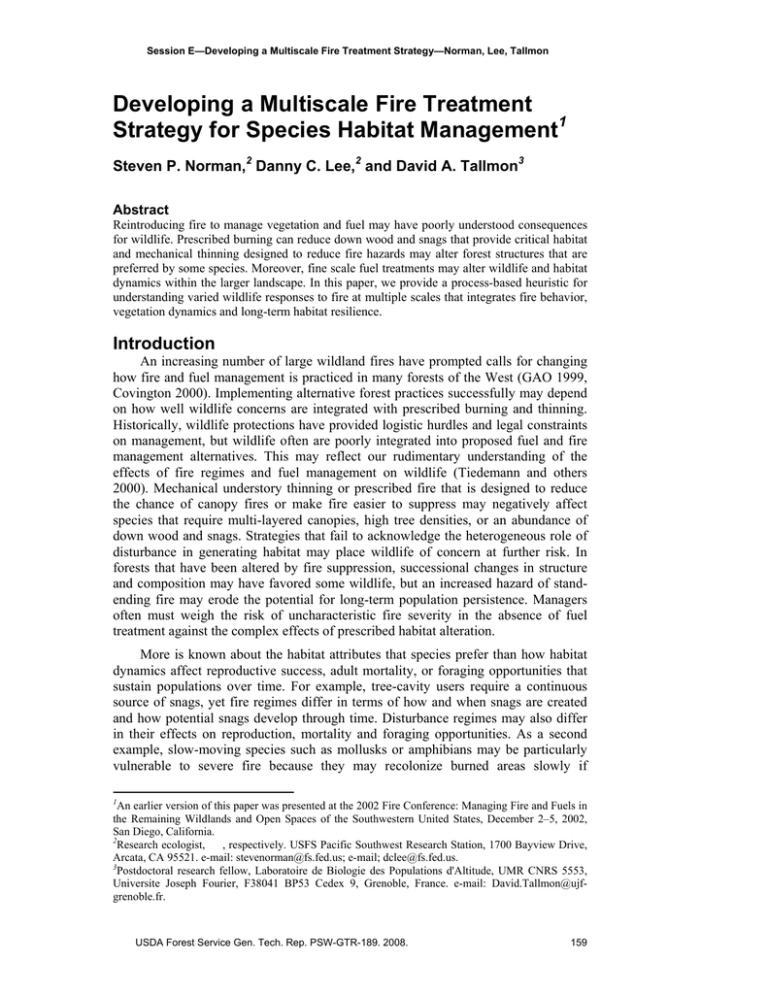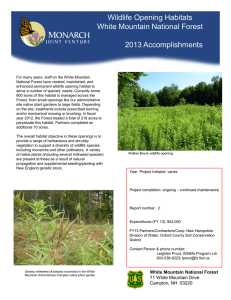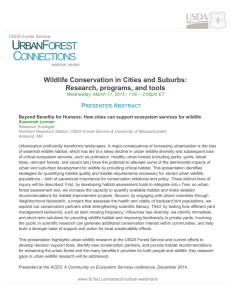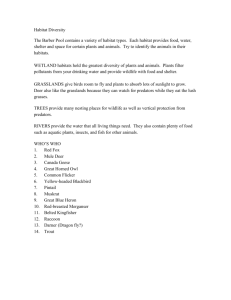Developing a Multiscale Fire Treatment Strategy for Species Habitat Management
advertisement

Session E—Developing a Multiscale Fire Treatment Strategy—Norman, Lee, Tallmon Developing a Multiscale Fire Treatment Strategy for Species Habitat Management1 Steven P. Norman,2 Danny C. Lee,2 and David A. Tallmon3 Abstract Reintroducing fire to manage vegetation and fuel may have poorly understood consequences for wildlife. Prescribed burning can reduce down wood and snags that provide critical habitat and mechanical thinning designed to reduce fire hazards may alter forest structures that are preferred by some species. Moreover, fine scale fuel treatments may alter wildlife and habitat dynamics within the larger landscape. In this paper, we provide a process-based heuristic for understanding varied wildlife responses to fire at multiple scales that integrates fire behavior, vegetation dynamics and long-term habitat resilience. Introduction An increasing number of large wildland fires have prompted calls for changing how fire and fuel management is practiced in many forests of the West (GAO 1999, Covington 2000). Implementing alternative forest practices successfully may depend on how well wildlife concerns are integrated with prescribed burning and thinning. Historically, wildlife protections have provided logistic hurdles and legal constraints on management, but wildlife often are poorly integrated into proposed fuel and fire management alternatives. This may reflect our rudimentary understanding of the effects of fire regimes and fuel management on wildlife (Tiedemann and others 2000). Mechanical understory thinning or prescribed fire that is designed to reduce the chance of canopy fires or make fire easier to suppress may negatively affect species that require multi-layered canopies, high tree densities, or an abundance of down wood and snags. Strategies that fail to acknowledge the heterogeneous role of disturbance in generating habitat may place wildlife of concern at further risk. In forests that have been altered by fire suppression, successional changes in structure and composition may have favored some wildlife, but an increased hazard of standending fire may erode the potential for long-term population persistence. Managers often must weigh the risk of uncharacteristic fire severity in the absence of fuel treatment against the complex effects of prescribed habitat alteration. More is known about the habitat attributes that species prefer than how habitat dynamics affect reproductive success, adult mortality, or foraging opportunities that sustain populations over time. For example, tree-cavity users require a continuous source of snags, yet fire regimes differ in terms of how and when snags are created and how potential snags develop through time. Disturbance regimes may also differ in their effects on reproduction, mortality and foraging opportunities. As a second example, slow-moving species such as mollusks or amphibians may be particularly vulnerable to severe fire because they may recolonize burned areas slowly if 1 An earlier version of this paper was presented at the 2002 Fire Conference: Managing Fire and Fuels in the Remaining Wildlands and Open Spaces of the Southwestern United States, December 2–5, 2002, San Diego, California. 2 Research ecologist, , respectively. USFS Pacific Southwest Research Station, 1700 Bayview Drive, Arcata, CA 95521. e-mail: stevenorman@fs.fed.us; e-mail; dclee@fs.fed.us. 3 Postdoctoral research fellow, Laboratoire de Biologie des Populations d'Altitude, UMR CNRS 5553, Universite Joseph Fourier, F38041 BP53 Cedex 9, Grenoble, France. e-mail: David.Tallmon@ujfgrenoble.fr. USDA Forest Service Gen. Tech. Rep. PSW-GTR-189. 2008. 159 Session E—Developing a Multiscale Fire Treatment Strategy—Norman, Lee, Tallmon extirpated. Places that are least likely to burn severely or frequently because of wildfire behavior and topography may provide disturbance-based refugia for improved conservation. Such process-based management requires a sophisticated knowledge of wildlife life history attributes and habitat dynamics. This understanding includes how population and vegetation dynamics interact within the larger landscape because habitat context (i.e., neighborhood effects) and habitat configuration are important (George and Zack 2001, Crist and others in press). In this paper, we integrate wildlife life history attributes with two distinct types of vegetation dynamics that are related to differences in fire behavior. We identify wildlife response groups that reflect population responses to these fire effects. Wildlife Response Models To integrate vegetation dynamics with wildlife responses to fire, we adapted a classification developed to describe plant responses to fire (Rowe 1983). In doing so, we expand on wildlife responses to fire that have been proposed by others (Oliver and others 1998, Hoff and Smith 2000). Use of this classification conceptually links wildlife responses to compositional responses of vegetation to fire. In restructuring the concept for wildlife habitat resilience, however, the response of vegetation structure to fire is also important. In our models, we address habitat structure by distinguishing between local and landscape fire effects. In the hierarchical classification below, the first group, site recolonization, typically results from radical changes in habitat structure and composition that occur in forest systems that experience stand-ending fire. The second group, site persistence, results from standmodifying fire. Species responses are further distinguished within each of these two groups. Model 1: Site Recolonization Stand-ending fire profoundly changes wildlife habitat. Severe fire replaces living trees of the pre-fire forest with large numbers of snags and early successional habitat. Wildlife must quickly adjust to this change in habitat, and some species are well-adapted to take advantage of the post fire conditions. Over a half century ago, G. Evelyn Hutchinson referred to post-fire colonizers as “fugitive species” because they regularly move into recently burned areas in response to the availability of new habitat (Hutchinson 1951). In disturbance prone forests, however, all successiondependent species (both early and late) can be considered fugitive when forest patches are dynamic in time and space. In an idealized model of patch dynamics, a stand-ending fire regime provides a shifting steady-state mosaic in the larger landscape (Bormann and Likens 1979). At any given location, successional changes in forest structure and composition predominantly reflect the time since the last fire (Oliver 1981). Wildlife responses to these changes in habitat can be classified according to when habitat becomes optimal (fig. 1). Invaders require recently burned areas for demographic success. Productivity quickly rises from unsustainable to optimal values in the years following fire. One of the best examples of this population response is the black backed woodpecker (Picoides arcticus) that thrives on the larvae of wood-boring bark beetles associated with recently burned areas (Hutto 1995). Over subsequent years and decades, habitats become suitable for different species according to species’ life history needs and the course of vegetation change (Thomas 1994, Oliver et al. 1998). Avoiders are species that thrive in association with old trees, an abundance of down wood, and structurally 160 USDA Forest Service Gen. Tech. Rep. PSW-GTR-189. 2008. Session E—Developing a Multiscale Fire Treatment Strategy—Norman, Lee, Tallmon Population growth rate complex forests. An example of an Avoider is the winter wren (Troglodytes troglodytes) that is typically associated with late seral forests (McGarigal and McComb 1995). FIRE Time Invader Avoider Figure 1—Wildlife responses of site recolonization for highly mobile species. The recolonization potential of highly mobile bird and mammal species differs from that of less mobile species. Patch configuration may be especially important for colonizers that are relatively immobile or sensitive to edge effects. Colonizers may be sensitive to the distance between patches and the availability of migration corridors (Wiens and others 1985, Noss 1991). Edge effects may increase predation risk and provide limited effective habitat for maintaining wildlife populations. Only in a simplified patch dynamics model can disturbance, succession, and recolonization result in a predictable chronosequence of wildlife at a given site. Within a landscape, an idealized flow of fugitive species among successional patches consists of a metapopulation-like dynamic (Pulliam 1988, Thomas 1994). Patches that provide optimal habitat act as demographic sources, while patches of sub-optimal quality are demographic sinks. The condition of habitat at all sites is ephemeral, however, and the continuity of habitat over time is evident at the scale of the entire landscape, rather than the individual patch. The eventual loss of optimal habitat is to be expected within a given patch because of successional change and the inevitable stand-ending fire. This shifting-steady state model of wildlife recolonization provides a useful heuristic if the landscape is homogenous and all areas have an equal probability of burning, but this is rarely the case. Historically, fire frequency varied across mountainous landscapes, often in concert with changes in vegetation (Camp and others 1997). While the steady-state mosaic model incorporates sources and sinks that are constantly shifting, a model that includes relatively fire-free refugia includes somewhat stable source and sink areas. These refugia burn less often than the landscape as a whole, and are most likely to provide old trees, snags, and down wood. Such geographically stable habitats may function as persistent sources of emigrants and provide key habitat for the preservation of wildlife in a landscape over time (Crist and others in press). USDA Forest Service Gen. Tech. Rep. PSW-GTR-189. 2008. 161 Session E—Developing a Multiscale Fire Treatment Strategy—Norman, Lee, Tallmon Model 2: Site persistence In contrast to the recolonization response of wildlife described above, some wildlife populations persist at a site through repeated fires. This is largely possible because fire effects on habitat are less severe than those of stand-ending fire. A fire regime of low to moderate severity does not result in radical changes in forest structure and is more likely to burn with variable intensity. That historical fires burned with low intensity in some forests is evidenced by fire scar analysis of individual trees that survived repeated fires. Reconstructed stand structures indicate that trees were typically clumped rather than regularly distributed. This structural complexity would have resulted in variable patterns of surface fuel accumulation and burn intensity. The fine scale heterogeneity of fire severity may have included unburned or lightly burned areas within the fire perimeter (Baker and Ehle 2001). Spotty areas of high fire intensity may have been associated with concentrations of shrubs, thickets of young trees, or down wood. In non-severe fire weather, such fuel structures may have resulted in intense, but passive crown fires. In the past, a sustained regime of patchy fire may have contributed to the resilience of these forests, although the way in which fire results in fine scale heterogeneity is poorly understood (Miller and Urban 1999). Some degree of fine scale variability in fire severity is common in recent wildfires (Lertzman and others 1998) and prescribed fires (Kauffman and Martin 1989). The creation of a burn mosaic is often an explicit goal of prescribed burning for wildlife management (Brownlie and Engstrom 2001). Relatively high fire frequency and low fire severity generates an assemblage of habitat elements that is distinct from that of patch dynamics. A stand-modifying fire regime may result in aggregations of fire-resistant trees (Bonnicksen and Stone 1982), but down wood and snags may be lost unless unburned areas are present. Dry exposed wood is highly vulnerable to ignition from fire brands from adjacent trees and may readily combust from radiant heat. Moreover, snags that result from a fire may be less durable than those caused by other factors (Morrison and Raphael 1993). A loss of snags and down wood will likely reduce habitat for those species that depend on them, but a regime of frequent, low intensity fire perpetuates live tree structure for centuries. From the perspective of wildlife that thrive in these forests, a low-intensity fire regime provides a second type of refugia—one of chronic disturbance. Unlike refugia that burned less often than the surrounding landscape, these refugia provide relative protection from stand-ending fire that would require renewed succession and recolonization. Wildlife populations may respond positively or negatively to stand-modifying fire, or they may show no notable response (fig. 2). What distinguishes this group from the recolonizer responses is that a substantial number of individuals persist at a site following disturbance. The demographic success of Endurers is reduced after fire, but the population is able to recover without external subsidy from unburned populations. Exploiters show increased success in response to the fire, but habitat requirements are only temporarily improved over background levels. Resisters are not affected by fire. This latter response may be typical of generalist species or it may occur because fires are of sufficiently low intensity to not significantly modify critical habitat attributes. These disparate responses of wildlife to fire are linked to species’ life history attributes and to subtle fire characteristics. Nuances in the heterogeneity of burn severity and season of individual fires may affect the vegetation response to fire and the subsequent quality of habitat for wildlife. 162 USDA Forest Service Gen. Tech. Rep. PSW-GTR-189. 2008. Population growth rate Session E—Developing a Multiscale Fire Treatment Strategy—Norman, Lee, Tallmon FIRE Time Endurer Exploiter Resister Figure 2—Wildlife responses of site persistence. Integrating fire and wildlife management Fire management strategies can integrate wildlife concerns better by being sensitive to how wildlife responds to vegetation dynamics. Management of systems that provide wildlife resilience through frequent low severity fire may fail when fire exclusion forces species to contend with uncharacteristically severe, stand-ending fire. Many species may be poorly adapted for recolonization. Moreover, requisite habitat structures may not develop in the absence of frequent fire or specificallytailored fire surrogate treatments. In other areas, habitats that were sustained by stand-ending fire may be degraded at the landscape scale if fire is replaced by selective thinning to make stands artificially fire resilient. Sensitivity to the effects of different disturbance regimes is important for maintaining quality habitat over time. Landscapes that are managed for site recolonization by wildlife require fuel treatment strategies that are consistent with wildlife adaptations. Strategies might include the following: 1) build redundancy of seral classes into the landscape, 2) ensure migration access among patches, 3) identify and maintain refugia that naturally burn infrequently and assess their importance for maintaining rare species, and 4) maintain disturbance size, edge, interior and openings within a desired range of variability. In forests, that historically experienced stand-ending fire, 20th century fire exclusion may have reduced the areas in mid age classes—thereby placing future recolonization at risk as stand-ending fire eliminates old forest habitat. Managers might weigh the relative effects to wildlife of severe wildfire, stand ending prescribed fire, and emulative silviculture. Stand-ending wildfires are difficult to control, however, and extensive high severity fire is rarely prescribed outside high-elevation wilderness areas because of social and ecological constraints. In contrast to recolonization-based management of habitat, ensuring site persistence may require fine scale fuel treatments when habitat dynamics have significantly changed from historical conditions. Management strategies may include the following: 1) restore fine-scale forest structure to increase the heterogeneity of fire severity, 2) burn during non-extreme weather for patchy effects (e.g., nocturnal or cool season burning), and 3) individually target old trees, snags, logs (e.g., raking, spot thinning, covering logs with soil, variable drip torch burn strategies). This finescale surgical approach to habitat management may be difficult because it involves high cost and effort depending on the degree that current conditions depart from the USDA Forest Service Gen. Tech. Rep. PSW-GTR-189. 2008. 163 Session E—Developing a Multiscale Fire Treatment Strategy—Norman, Lee, Tallmon habitat-sustaining dynamic. Our understanding of the subtle effects of fine scale fire dynamics on wildlife processes is more limited than it is for the radical effects of stand-ending fire, and this is especially true for rare species that typically constrain management the most. Conclusion In conclusion, the ecological effects of fire on wildlife are complex, but an improved integration of fire and fuel management with wildlife will be possible when habitat dynamics are more fully understood. An assessment of how historical habitat dynamics functioned may provide insight into how prescribed fire and fire surrogate treatments can be designed to better accommodate wildlife at coarse and fine scales. In this paper, we have provided a conceptual model that pairs two different habitatgenerating processes with two fundamental wildlife responses to fire. We believe that this provides a useful heuristic for broad scale planning. Desired future conditions for wildlife and forests should incorporate these key scale-specific processes while being sensitive to social and ecological constraints. Acknowledgments This research was supported under Project 01.PSW.A.1 of the National Fire Plan, an interagency effort funded in part by the USDA Forest Service. References Baker, W.L.; Ehle, D. 2001. Uncertainty in surface-fire history: the case of ponderosa pine forests in the western United States. Canadian Journal of Forest Research 31(7): 1205– 1226. Bonnicksen, T.M; Stone, E.C. 1982. Reconstruction of a presettlement giant sequoia-mixed conifer forest community using the aggregation approach. Ecology 63: 1134–1148. Bormann, F.H.; Likens, G.E. 1979. Catastrophic disturbance and the steady state in northern hardwood forests. American Scientist 67: 660–669. Brownlie, D.J.; Engstrom, R.T. 2001. Use of prescribed fire for bird management in the Eastern United States: survey results. Reporting Fire Management Activities in The Nature Conservancy 9(1). Online at http://www.tncfire.org/ vol9no1.htm. Camp, A.; Oliver, C.; Hessburg, P.F.; Everett, R. 1997. Predicting late successional fire refugia pre-dating European settlement in the Wenatchee Mountains. Forest Ecology and Management 95: 63–77. Covington, W.W. 2000. Helping western forests heal. Nature 408: 135–136. Crist, M.R.; McGarigal, K.; Romme, W.H.; Roworth, E.T.; In press. Quantifying spatial and temporal dynamics in wildlife habitat under a historic fire regime in the southern Rocky Mountains. Ecological Applications. GAO. 1999. Western National Forests: A cohesive strategy is needed to address catastrophic wildfire threats. U.S. General Accounting Office GAO/RCED-99-65. George, T.L.; Zack, S. 2001. Spatial and temporal considerations in restoring habitat for wildlife. Restoration Ecology 9(3): 272–279. 164 USDA Forest Service Gen. Tech. Rep. PSW-GTR-189. 2008. Session E—Developing a Multiscale Fire Treatment Strategy—Norman, Lee, Tallmon Hoff, M.H.; Smith, J.K. 2000. Fire effects on animal communities. In: Smith, J.K. ed. Wildland fire in ecosystems: effects of fire on fauna, Gen. Tech. Rept. RMRS-GTR-42vol.1. Rocky Mountain Research Station, Forest Service, U.S. Department of Agriculture; 35–49. Hutchinson, G.E. 1951. Copepodology for the ornithologist. Ecology 32(3): 571–577. Hutto, R.L. 1995. Composition of bird communities following stand-replacement fires in northern Rocky-Mountain (USA) conifer forests. Conservation Biology 9(5): 1041– 1058. Kauffman, J.B.; Martin, R.E. 1989. Fire behavior, fuel consumption, and forest-floor changes following prescribed understory fires in Sierra Nevada mixed conifer forests. Canadian Journal of Forest Research 19(4): 455–462. Lertzman, K.; Fall, J.; Dorner, B. 1998. Three kinds of heterogeneity in fire regimes: at the crossroads of fire history and landscape ecology. Northwest Science 72: 4–23. McGarigal, K.; McComb, W.C. 1995. Relationship between landscape structure and breeding birds in the Oregon Coast Range. Ecological Monographs 65(3): 235–260. Miller, C.; Urban, D.L. 1999. Interactions between forest heterogeneity and surface fire regimes in the southern Sierra Nevada. Canadian Journal of Forest Research 29: 202– 212. Morrison, M.L.; Raphael, M.G. 1993. Modeling the dynamics of snags. Ecological Applications 3(2): 322–330. Noss, R.F. 1991. Landscape connectivity: different functions at different scales. In: W.E Hudson, ed. Landscape Linkages and Biodiversity:Defenders of Wildlife, Washington, DC.\ Oliver, C.D. 1981. Forest development in North America following major disturbances. Forest Ecology and Management 3(3): 153–168. Oliver, C.D.; Osawa, A.; Camp, A. 1998. Forest dynamics and resulting animal and plant population changes at the stand and landscape scales. Journal of Sustainable Forestry 6(3/4): 281–312. Pulliam, H.R. 1988. Sources, sinks, and population regulation. American Naturalist 132: 652–661. Rowe, J.S. 1983. Concepts of fire effects on plant individuals and species. In: Wein, R.W.; MacLean, D.A. The role of fire in northern circumpolar ecosystems, Chichester: John Wiley and Sons; 135–154. Thomas, C.D. 1994. Extinction, colonization, and metapopulations: environmental tracking by rare species. Conservation Biology 8(2): 373–378. Tiedemann, A.R.; Klemmedson, J.O.; Bull, E.L. 2000. Solution of forest health problems with prescribed fire: Are forest productivity and wildlife at risk? Forest Ecology and Management 127(1-3): 1–18. Wiens, J.A.; Crawford, C.S.; Gosz, J.R. 1985. Boundary dynamics: a conceptual framework for studying landscape ecosystems. Oikos 45: 421–427. USDA Forest Service Gen. Tech. Rep. PSW-GTR-189. 2008. 165 This page intentionally left blank. 166 USDA Forest Service Gen. Tech. Rep. PSW-GTR-189. 2008.






